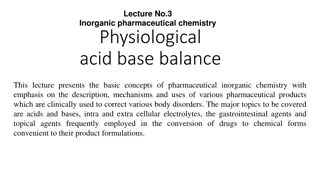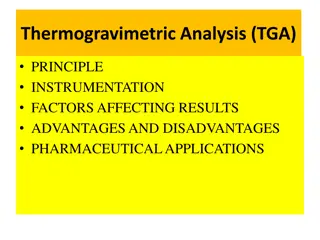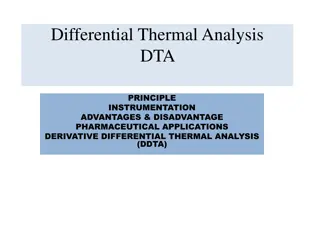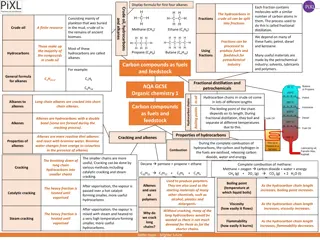Advanced Pharmaceutical Analysis: Alkanes, Branched Alkanes, Cycloalkanes
In this lecture series, the analysis of alkanes, branched alkanes, and cycloalkanes is explored. Topics include the characteristics of straight-chain alkanes, the fragmentation patterns of branched alkanes, and the unique peaks of cycloalkanes in mass spectrometry. Understanding these concepts is crucial for identifying and analyzing pharmaceutical compounds accurately.
Download Presentation

Please find below an Image/Link to download the presentation.
The content on the website is provided AS IS for your information and personal use only. It may not be sold, licensed, or shared on other websites without obtaining consent from the author.If you encounter any issues during the download, it is possible that the publisher has removed the file from their server.
You are allowed to download the files provided on this website for personal or commercial use, subject to the condition that they are used lawfully. All files are the property of their respective owners.
The content on the website is provided AS IS for your information and personal use only. It may not be sold, licensed, or shared on other websites without obtaining consent from the author.
E N D
Presentation Transcript
StudyMafia.Org Trigonometry Submitted To: Submitted By: Studymafia.org Studymafia.org
Table Contents Definition Introduction Trigonometric Functions TrigonometryAngles TrigonometryTable TrigonometryFormulas TrigonometryBasics Trigonometry Examples Application of Trigonometry Conclusion 2
Definition Trigonometry is one of the important branches in the history of mathematics that deals with the study of the relationship between the sides and angles of a right-angled triangle. 3
Introduction The branch called Trigonometry basically deals with the study of the relationship between the sides and angles of the right-angle triangle. Hence, it helps to find the missing or unknown angles or sides of a right triangle using the trigonometric formulas, functions or trigonometric identities. Some of the most commonly used trigonometric angles for calculations are 0 , 30 , 45 , 60 and 90 . 4
Trigonometric Functions The six important trigonometric functions (trigonometric ratios) are calculated using the below formulas and considering the above figure. It is necessary to get knowledge about the sides of the right triangle because it defines the set of important trigonometric functions. 6
Trigonometric Functions Odd trigonometric functions: A trigonometric function is said to be an odd function if f(-x) = -f(x) and symmetric with respect to the origin. Even trigonometric functions: A trigonometric function is said to be an even function, if f(-x) = f(x) and symmetric to the y-axis. 8
Trigonometric Functions Therefore, cosine and secant are the even trigonometric functions, whereas sine, tangent, cosecant and cotangent are the odd trigonometric functions. Sin (-x) = Sin x Cos (-x) = Cos x Tan (-x) = -Tan x Csc (-x) = Csc x Sec (-x) = Sec x Cot (-x) = -Cot x 9
Trigonometry Angles The trigonometry angles which are commonly used in trigonometry problems are 0 , 30 , 45 , 60 and 90 . The trigonometric ratios such as sine, cosine and tangent of these angles are easy to memorize. To find these angles we have to draw a right- angled triangle, in which one of the acute angles will be the corresponding trigonometry angle. These angles will be defined with respect to the ratio associated with it. 10
Trigonometry Angles For example, in a right-angled triangle, Sin = Perpendicular/Hypotenuse or = sin-1 (P/H) Similarly, = cos-1 (Base/Hypotenuse) = tan-1 (Perpendicular/Base) 11
Trigonometry Formulas Pythagorean Identities sin + cos = 1 tan2 + 1 = sec2 cot2 + 1 = cosec2 sin 2 = 2 sin cos cos 2 = cos sin tan 2 = 2 tan / (1 tan ) cot 2 = (cot 1) / 2 cot 13
Trigonometry Formulas If A, B and C are angles and a, b and c are the sides of a triangle, then, Sine Laws a/sinA = b/sinB = c/sinC Cosine Laws c2 = a2 + b2 2ab cos C a2 = b2 + c2 2bc cos A b2 = a2 + c2 2ac cos B 15
Trigonometry Formulas The three important trigonometric identities are: sin + cos = 1 tan + 1 = sec cot + 1 = cosec 16
Trigonometry Formulas Euler s Formula for trigonometry As per the euler s formula, 17
Trigonometry Basics The three basic functions in trigonometry are sine, cosine and tangent. Based on these three functions the other three functions that are cotangent, secant and cosecant are derived. All the trigonometrical concepts are based on these functions. 18
Trigonometry Basics If is the angle in a right-angled triangle, then Sin = Perpendicular/Hypotenuse Cos = Base/Hypotenuse Tan = Perpendicular/Base Perpendicular is the side opposite to the angle . The base is the adjacent side to the angle . 19
Trigonometry Basics The hypotenuse is the side opposite to the right angle Cot = 1/tan Sec = 1/cos Cosec = 1/sin Hence, Cot = Base/Perpendicular Sec = Hypotenuse/Base Cosec = Hypotenuse/Perpendicular 20
Trigonometry Examples There are many real-life examples where trigonometry is used broadly. If we have been given with height of the building and the angle formed when an object is seen from the top of the building, then the distance between object and bottom of the building can be determined by using the tangent function, such as tan of angle is equal to the ratio of the height of the building and the distance. 22
Trigonometry Examples Let us say the angle is , then Tan = Height/Distance between object & building Distance = Height/Tan Let us assume that height is 20m and the angle formed is 45 degrees, then Distance = 20/Tan 45 Since, tan 45 = 1 So, Distance = 20 m 23
Applications of Trigonometry Its applications are in various fields like oceanography, seismology, meteorology, physical sciences, astronomy, acoustics, navigation, electronics, etc. It is also helpful to measure the height of the mountain, find the distance of long rivers, etc. 24
Conclusion Trigonometry (from Ancient Greek (tr g non) 'triangle', and (m tron) 'measure') is a branch of mathematics that studies relationships between side lengths and angles of triangles. 25
Thanks To StudyMafia.org























